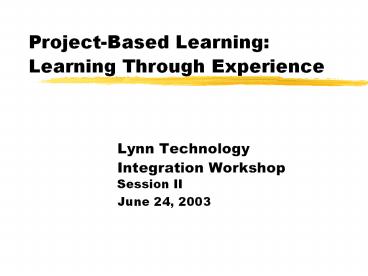Project-Based Learning: Learning Through Experience - PowerPoint PPT Presentation
Title:
Project-Based Learning: Learning Through Experience
Description:
Project-Based Learning: Learning Through Experience Lynn Technology Integration Workshop Session II June 24, 2003 Contact Information: Sylvia Klinzing (sklinzing_at_sun ... – PowerPoint PPT presentation
Number of Views:704
Avg rating:3.0/5.0
Title: Project-Based Learning: Learning Through Experience
1
Project-Based Learning Learning Through
Experience
- Lynn Technology Integration Workshop Session II
- June 24, 2003
2
Contact Information
Sun Associates www.sun-associates.com 978-251-1600
- Sylvia Klinzing (sklinzing_at_sun-associates.com)
- Laura Tilton (ltilton_at_sun-associates.com)
- http//www.sun-associates.com/lynn
3
PBL Why do it?
- Supportive Research
- Increased Motivation
- Measurable Results
- Authentic Products
4
PBL What is it?
- Is project-based the same as problem-based
learning? - What are the basic elements of project-based
learning (PBL)? - What makes a good PBL project?
5
Project-Based vs. Problem-Based Learning
Both are. authentic, constructivist, inqui
ry-based, and student-centered
approaches.
6
Project-Based Problem-Based Learning Learning
- Tends to be associated with K-12 education
- Originated in medical training and other
professional preparation practices
- Organized around an end product or artifact
- Organized around a problem for students to solve
(i.e. case study)
- End product is elaborate, and may require
extensive planning and labor.
- End products are simpler, more summative.
7
4 Basic Elements of PBL
- Extended time frame
- Collaboration
- Student-directed Investigation
- Construction of a real world product/artifact
8
Extended Time Frame
- Projects run anywhere from
A few weeks
An entire year
------
- What is the value of an extended time frame?
- allows in depth interaction with the subject
- allows construction of a worthwhile, real world
product.
9
Collaboration
- Students can work in groups and/or work with
other classes via the internet.
- What is the value of collaboration?
- allows feedback from peers
- makes the task/s less daunting
- distributes expertise and responsibility
- exposes students to other perspectives
10
Student-directed Investigation
- Involves one or more of the following
researching background info, observing,
collecting data, conducting interviews, sharing
and analyzing data. - Why do it?
- Gives students an opportunity to personally
explore the subject - Hones skills that could be useful outside the
classroom
11
Construction of a Real World Product/Artifact
- Can range from being
Template driven
Open-ended
------
- Why construct real world products?
- they are authentic, and so have a wider audience
base - they motivate and engage students
- they often appeal to more than one learning style
12
Types of Tasks
Key idea Transforming knowledge
- Consensus Building
- Persuasion
- Self-knowledge
- Judgement
- Analytical
- Scientific
- Retelling
- Compilation
- Mystery
- Journalistic
- Design
- Creative Product
For further explanations and other examples,
see http//webquest.sdsu.edu/taskonomy.html
13
Examples of Products for Assessment
- Physical model
- Multimedia presentation
- Website
- Video/radio program
- Mock trial
- Journal
- Letter/e-mail message
- Book, brochure, newspaper article, poster
- Poem, song, puzzle, art project
- A policy paper/ recommendation to some government
body
14
PBL Challenges
- Time
- Classroom management
- Control
- Support of student learning
- Technology use
- Assessment
15
(No Transcript)
16
Characteristics of a Good PBL Activity (45 mins)
- Break up into small groups of 3 or 4 (form K-5 or
6-12 groups). - Compare and contrast your worksheets with other
learners - Write down some insights from your discussion.
- Share with the entire group.
17
Great Planning is Key to Problem-Based Learning!
18
(No Transcript)
19
Steps in Planning (LEVEL 2)
- List the major goals of the project and
curricular tie-ins - Decide on project duration
- Plan Activities
- Develop specific questions/challenges
- Browse pre-existing PBLs, other sources
- Draft assessment goals (what, how and when to
assess)
20
Checklist
- Will your PBL Activity
- tie-in well with the curriculum?
- engage and build on students' own interests and
passions? - allow for open-ended outcomes and products?
- provide a meaningful and authentic context for
learning? ...
- Major goals
21
(No Transcript)































